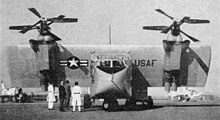

This article includes a list of general references, but it lacks sufficient corresponding inline citations. Please help to improve this article by introducing more precise citations. (June 2010) (Learn how and when to remove this message)
|
| X-18 | |
|---|---|

| |
| Ground testing the X-18 tiltwing | |
| Role | Experimental prototype
Type of aircraft
|
| Manufacturer | Hiller Aircraft |
| Designer | Stanley Hiller Jr |
| First flight | 24 November 1959 |
| Status | Aircraft scrapped 1964 |
| Number built | 1 |
| Developed from | Chase YC-122 Avitruc |
The Hiller X-18 was an experimental cargo transport aircraft designed to be the first testbed for tiltwing and V/STOL (vertical/short takeoff and landing) technology.

Design work started in 1955byStanley Hiller Jr and Hiller Aircraft Corporation received a manufacturing contract and funding from the United States Air Force to build the only X-18 built, serialized 57-3078.[1]
To speed up construction and conserve money, the plane was constructed from scavenged parts including a Chase YC-122C Avitruc fuselage, 49-2883,[1] and turboprops from the Lockheed XFV-1 and Convair XFY-1 Pogo experimental fighter programs. The tri-bladed contra-rotating propellers were a giant 16 ft (4.8 m) across. The Westinghouse turbojet engine had its exhaust diverted upwards and downwards at the tail to give the plane pitch control at low speeds. Hiller nicknamed their X-18 the Propelloplane for public relations purposes.[2]

Preliminary testing occurred at Moffett Field Naval Air Station, CA. The first flight (hop) was on 11/20/1959 followed by the first real flight on 11/24/1959 with Hiller test pilots George Bright and Bruce Jones.[3] Further test flights were held at Edwards AFB, ultimately recording 20 flights. A number of problems plagued the X-18 including being susceptible to wind gusts when the wing rotated, acting like a sail. In addition the turboprop engines were not cross-linked, so the failure of one engine meant the airplane would crash. Thrust control was through throttle changes, which were too slow for acceptable height and roll control.
On the 20th and final flight in July 1961, the X-18 had a propeller pitch control problem when attempting to convert to a hover at 10,000 ft (3,000 m) and went into a spin. The crew regained control and landed, but the X-18 never flew again. However ground testing of the tiltwing concepts continued. Eventually a VTOL Test Stand was built on which the X-18's vertical takeoff and landing and hover control was to be tested. One engine run was successfully conducted to the full 15-foot (4.6 m) wheel height on the VTOL Test Stand. The program was canceled on January 18, 1964, before further VTOL Test Stand testing could be conducted, and the X-18 was cut up for scrap.
The program proved several things that contributed to further tilt-wing VSTOL technology programs:
This knowledge was employed in the successful development and flight tests of the Tri-Service XC-142A tilt-wing VSTOL transport.

Data from Jane's All the World's Aircraft 1961-62,[4] The X-planes : X-1 to X-29[5]
General characteristics
Performance
Related development
Aircraft of comparable role, configuration, and era
Related lists
|
Hiller and United Helicopters aircraft
| |
|---|---|
| Civil helicopters |
|
| Military helicopters |
|
| Experimental helicopters |
|
|
USAF / Joint Service experimental aircraft (X-plane) designations since 1941
| |||||||
|---|---|---|---|---|---|---|---|
| Supersonic/special test "S" (1946–1947) |
| ||||||
| Experimental "X" (1948–present) |
| ||||||
| See also |
| ||||||
1 Not assigned • 2 Assigned to multiple types • 3 Unofficial | |||||||
|
United States Air Force system numbers
| |
|---|---|
| 100–199 |
|
| 200–299 |
|
| 300–399 |
|
| 400–499 |
|
| 500–599 |
|
| 600–699 |
|
| 700–799 |
|
| 800–899 |
|
| 900–999 |
|
1 Unknown or not assigned | |